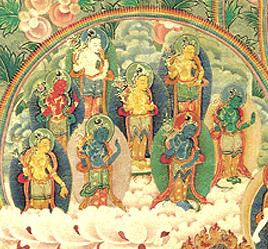Bodhisattva vow: Difference between revisions
Jump to navigation
Jump to search
No edit summary |
|||
| Line 19: | Line 19: | ||
==Internal Links== | ==Internal Links== | ||
*[[Eighteen root downfalls]] | *[[Eighteen root downfalls]] | ||
*[[Twenty Verses on the Bodhisattva Vow]] | |||
==External Links== | ==External Links== | ||
Revision as of 14:54, 17 July 2009

Bodhisattva vow (Wyl. byang sdom) — the commitment to become a bodhisattva, one who works to lead all sentient beings to perfect enlightenment.
Traditions of Bodhisattva Vow
There are two main traditions of bodhisattva vow: the tradition of Profound View, coming from Nagarjuna, and the tradition of Vast Conduct, coming from Asanga. In Asanga's tradition the vows of bodhichitta in aspiration and bodhichitta in action are taken separately, whereas in Nagarjuna's tradition they are taken together.
How to Take the Bodhisattva Vow
The vow consists of the preliminary practices, main part and conclusion.
- The preliminaries can consist of gathering the accumulations by means of the seven branch offering, training the mind and giving away the three possessions.
- The main part consists of taking the vows of bodhichitta in aspiration and action, either separately or together.
- The conclusion consists of rejoicing oneself and encouraging others to rejoice as well.
Further Reading
- Bokar Rinpoche, Taking the Bodhisattva Vow, Clearpoint Press, 1991.